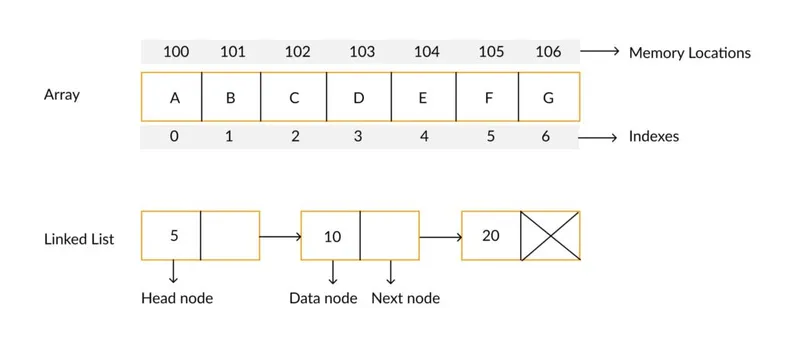A linked list is a linear data structure where elements are not stored next to each other in memory. Unlike and array, elements in a linked list use pointers or references to each other to keep the list intact.
Like arrays or traditional lists, linked lists are an ordered collection of objects. Linked lists stand apart from lists in how they store elements in memory. While regular lists like arrays and slices use a contiguous memory block to store references to their data linked lists store references or pointers as part of each element.

A normal list is just a pointer to the first element in the list, and a specific item can be retrieved by providing a memory offset.
A linked list is also just a pointer to the first element in the list, but memory offsets won’t do us any good. We need to examine the first element’s next pointer to see where the next item is, then we can navigate to it. From there, we can find the next item and so on down the list.
Python singly linked list example 🔗
Node Class 🔗
First, we’ll build a Node class. The LinkedList class we eventually build will be a list of Nodes.
class Node:
def __init__(self, val):
self.val = val
self.next = None
def set_next(self, node):
self.next = node
def __repr__(self):
return self.val
Each node has a val data member (the information it stores) and a next data member. The next data member just points to the next Node in the list if there is one, otherwise, it’s None
Linked List Constructor 🔗
class LinkedList:
def __init__(self):
self.head = None
The constructor is easy - just initialize an empty head pointer. This indicates we now have an empty list.
Iterating over the list 🔗
Let’s make it easy to iterate over each item in the list using Python’s for _ in _ syntax.
def __iter__(self):
node = self.head
while node is not None:
yield node
node = node.next
By implementing Python’s __iter__ method, we can now use iteration syntax. For example, for item in linked_list:.
Adding to the linked list 🔗
Let’s create a way to add items to the tail of the list, the add_to_tail method. It takes a node as input, iterates over the entire list, then adds the given node to the end.
def add_to_tail(self, node):
if self.head == None:
self.head = node
return
for current_node in self:
pass
current_node.set_next(node)
Removing from the linked list 🔗
There are other ways to remove items from the list, but for now, and as an example, let’s write a remove from head method.
def remove_from_head(self):
if self.head == None:
return None
temp = self.head
self.head = self.head.next
return temp
remove_from_head removes and returns the first item from the list, assuming one exists.
Printing the linked list 🔗
Last but not least, we can implement Python’s __repr__() method so that we can call print() directly on a list and control what it printed. Here’s a representation I like:
def __repr__(self):
nodes = []
for node in self:
nodes.append(node.val)
return " -> ".join(nodes)
This method will print each node’s value in order, with arrows in between. For example, hello -> this -> is -> my -> list.
Using the linked list 🔗
linked_list = LinkedList()
linked_list.add_to_tail(Node('john'))
linked_list.add_to_tail(Node('sally'))
linked_list.add_to_tail(Node('jimmy'))
print("ll:", linked_list)
first = linked_list.remove_from_head()
print("removed:", first)
print("ll:", linked_list)
Practical Applications of a Linked List 🔗
Linked lists are immensely valuable in computer science because they uniquely allow us to add and remove elements anywhere in the list quickly, with a Big-O complexity of just O(1).
Big-O complexity of a linked list 🔗
| Operation | Big-O Complexity |
|---|---|
| Insert | O(1) |
| Delete | O(1) |
| Index | O(n) |
Because of the fast operations, linked lists are used practically in many different scenarios, including:
- Stacks
- Queues
- Hash maps, to prevent collisions
- Undo/Redo operations (stack)
- Appending a song to a playlist
- To keep items in the same place in memory for performance reasons
Full Linked List Code Sample 🔗
class LinkedList:
def __init__(self):
self.head = None
def __iter__(self):
node = self.head
while node is not None:
yield node
node = node.next
def __repr__(self):
nodes = []
for node in self:
nodes.append(node.val)
return " -> ".join(nodes)
def add_to_tail(self, node):
if self.head == None:
self.head = node
return
for current_node in self:
pass
current_node.set_next(node)
def remove_from_head(self):
if self.head == None:
return None
temp = self.head
self.head = self.head.next
return temp
class Node:
def __init__(self, val):
self.val = val
self.next = None
def set_next(self, node):
self.next = node
def __repr__(self):
return self.val




